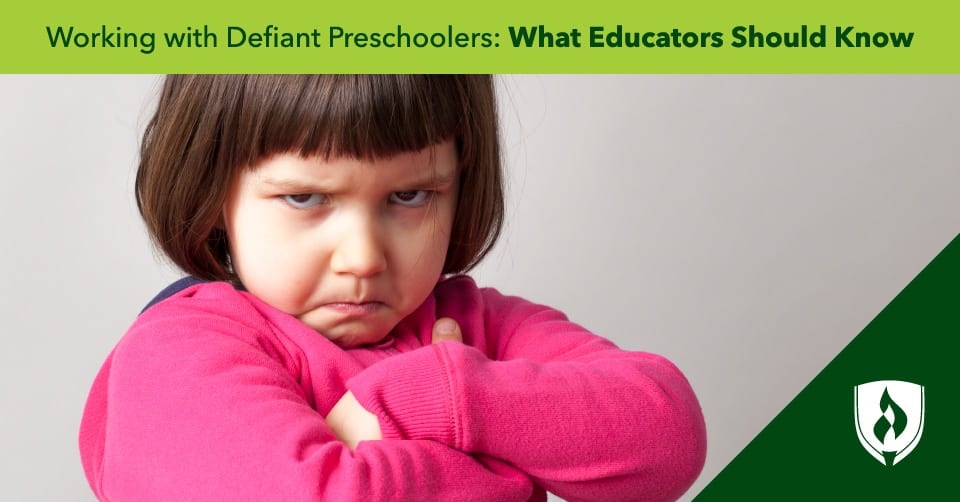
It’s a scenario you’ve likely lived plenty of times over. You’re waiting in the checkout lane of a grocery store and notice something that makes your heart beat faster—a young child nearby is starting to make a scene.
Soon, this scene grows more dramatic as fellow shoppers notice the child who is flailing, stomping or screaming about whatever item they just had to have but clearly aren’t getting. You and the other shoppers do your best to avoid looking directly at what is going down—but much like a car crash—it’s hard not to gawk.
In this scenario, you’ll probably notice some mixed feelings in the crowd. Some have a knowing sense of compassion, while others judge mercilessly believing their child would never do that. All you know is that this perfectly ordinary grocery trip has been completely upended by a screaming child. So, what exactly is going on here? Are tantrums a rite of passage every child will go through?
As much as it can test the patience of parents and caregivers, defiance is a regular part of growing up, and this testing of boundaries is completely normal for young children. But how can you tell when it is crossing a line? What is the best possible way to deal with outbursts like this? We’ve interviewed various early childhood education (ECE) professionals to get their answers to these questions and more. Read on to find out what exactly is going on in a child’s development, how ECE educators can best handle situations like this and what kind of follow-up to these incidents is most appropriate.
What is happening to a child during an outburst?
Tantrums themselves are a regular part of being a child. Most commonly, tantrums take place because of a lack of ability for a young child to properly express themselves. When a child doesn’t have the words to express what they are feeling, it is easy for them to get frustrated, and that frustration only continues to grow when it is met with a seeming lack of understanding from their parent or guardian.
While tantrums typically do decrease as language skills improve, it does not mean that they leave altogether. Depending on the previous “success” of a tantrum, it may be seen as a tool that a child begins to rely on more often to communicate wants and needs.
Another important factor to consider for preschool-age kids is all the changes that they are beginning to experience. New adults in a new setting, new peers, new expectations—there is a lot of “new” for these kids to contend with.
“Children display defiant behavior for a number of reasons, but one often overlooked explanation is anxiety,” says Carolyn Jarecki, a K–8 school guidance coach. Jarecki says the number of students she is seeing has doubled each of the last three years as kids have had to adjust to life in a post-pandemic world. Anxiety-driven behavior can be hard for adults to get a handle on—and it certainly isn’t any easier for quickly developing children.
With that in mind, understanding is key. But even educators who have this understanding still need some strategies for dealing with children exhibiting defiant behavior. The following strategies are designed to help kids understand that there are other ways to communicate their feelings, needs and desires beyond defiant outbursts and tantrums.
How to work with defiant preschoolers
Different kids are going to respond better to different strategies. A big part of this process for a teacher may be trial and error, so as you read through some of these suggestions, don’t get discouraged if you’ve tried one and it didn’t immediately work.
Communicate in simple ways
The most immediate strategy is communication. It is important to remember that kids don’t have the vocabulary or understanding of what is going on to fully communicate what they are experiencing. Get on their level. “The conversation doesn’t have to be intellectual or complicated,” says Adam Cole, director of music at The Willow School. “Just a talk, or an exchange of words, or even traded drawings, so that the child recognizes that they are being heard.”
If you haven’t had success with your normal forms of communication (or perhaps you’ve been too frustrated), it is possible you could be falling into the trap of a power struggle. “Resistance is best overcome with tiny steps,” says Cole. “Avoid power struggles at all costs, and if power must be exercised, do it gently and slowly so there’s a lot less for the child to resist.”
It is possible that previous communication has resulted in a back-and-forth power struggle, and if that’s the case, Cole points out that it would be wise to debrief what happened with the child and discuss a better way to proceed next time.
Create incentives
Another helpful tool to use is behavior charts. While the exact inner workings of different charts may vary, the basic idea is this: Make a chart to track behavior, place it somewhere your child can easily see and use something like colored stickers to make the chart more interesting. If you are using this in a classroom, Jarecki recommends teaming up with parents and loved ones so they can create a similar system at home if they like.
“Set a simple goal, such as staying on the color green or yellow on the behavior chart at school three of the five days of the school week.” If the child meets the expectations of the chart, find a way to celebrate that success together.
Provide options
One helpful strategy that is often overlooked is the importance of providing kids with options. “When a preschooler is able to make small decisions along the way, they feel empowered and more willing to cooperate,” says Leah Thompson, a parent coach with Navigations Parenting.
Thompson points out that so much of the life of a preschooler is dictated by their parents when they are just beginning to discover their need for independence. Thompson points out that asking simple questions about what a child may prefer can go a long way in giving them that feeling of independence they crave.
When you are giving options, you have the opportunity to validate the child’s current feelings while modeling the behavior you are looking for. “Most defiant behavior boils down to a child wanting some freedom and independence,” says Sally Macaluso, a special education teacher at Tenderhearted Teacher. “You can let them know you understand their frustration while also letting them be a part of the decision-making process.” Macaluso describes how this may look when a child is upset about naptime.
Acknowledge that they are upset about naptime because they want to play more, then ask where they would like to nap or what they would like to hold during naptime. If they respond to your question and transition into naptime, tell them what a good job they are doing. All of these little steps can go a long way in helping a child feel independent, seen and heard.
At what point should I worry about defiant preschool behavior?
The first piece of advice that nearly all of the educators we spoke to shared was for those in charge to first take a big deep breath. As frustrating as a defiant child can be, nothing positive will come from an interaction where you’ve lost your cool.
“Take some breaths and remind yourself that this, too, shall pass,” says Jarecki.
Once you’ve made sure you are in a good head space, there are some common warning signs that might indicate follow-up with a professional would be warranted.
One concern is oppositional defiant disorder (ODD). “If you notice that this defiant behavior persists for prolonged periods, is becoming more frequent and is impacting a child’s relationships and/or performance in school and extracurricular activities, you may want to speak to the child’s parents about consulting their pediatrician and the school’s counselor to set up an evaluation,” Macaluso says.
It is important to remember that educators should not attempt to diagnose students but rather should communicate with the child’s family because there is a good chance the classroom behavior is taking place at home too. Jarecki suggests having these conversations in person or over the phone rather than by email because the distant tone of emails can cause barriers or lead to defensiveness.
Keep in mind that parents might feel anxious about seeking professional help for their children. Jarecki urges all educators to approach parents respectfully and remind them that “it takes a village to raise kids and sometimes we need help from others.”
Help with defiant preschoolers
It really does take a community to give children everything they need, and sometimes, you try every trick in the book while nothing seems to work. But defiance is a very normal part of being a preschooler. Some of the best ways to help are to enlist all the adults in these children’s lives in the process of helping shape new behavior.
Learning how to communicate and deal with newer and stronger emotions isn’t easy, so the roles of parents, family members and educators are key to helping kids develop properly. Is this kind of development something that you are interested in reading more about? Check out our articles “6 Ways to Encourage Social Development in Children", "Early Childhood Mental Health: 8 Things ECE Professionals Should Know".




